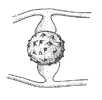Fungi, an Introduction
Fungi
The basic structural features of fungi are not cells but hyphae. Hyphae are microscopic branching threads. Each thread consists of a tube formed from a wall enclosing cytoplasm and a vacuole. The hyphal walls are not made of cellulose but of a substance called chitin, an organic nitrogenous compound. The hyphae contain many nuclei distributed throughout the cytoplasm. Sometimes the hyphae are divided into compartments by cross walls.
The fungi do not have chlorophyll so they cannot make their food in the way that plants do. They feed on dead or decaying organic matter and are classed as saprophytes. Their hyphae penetrate the dead material and form a branching network called a mycelium.
The tips of the growing hyphae produce enzymes which digest the organic material. The soluble products are absorbed into the hyphae.
When mould fungi, such as Rhizopus, grow on stale bread or rotting fruit, the mycelium can be seen as a greyish ‘fuzz’.
Rhizopus
Rhizopus is a mould fungus which grows on stale bread or rotting fruit. It reproduces asexually by sending up vertical hyphae each of which swells at the tip to produce a sporangium. The cytoplasm in the sporangium divides repeatedly to produce a mass of spores, each with a nucleus. When the sporangium breaks open, the spores are dispersed in the air, and each can grow to form a new mycelium if it lands on suitable material.
There is also a sexual method of reproduction, as follows:
(a) Adjacent hyphae put out protuberances.
(b) Where they meet, the tips of the hyphae swell and are cut off by cross walls. The nuclei divide rapidly.
(c) The intervening walls break down and the nuclei fuse in pairs.
The whole structure is now called a zygospore.
(d) The zygospore wall thickens and the hyphae shrivel. The thick-walled zygospore can remain dormant for a few months and can withstand drought and extremes of temperature.
(e) In suitable conditions the zygospore germinates to produce a single vertical hypha which forms a sporangium and releases its spores.
Sexual reproduction takes place only between two different strains of Rhizopus. The strains are visually indistinguishable but may have differences in their physiology, e.g. one may be able to digest organic matter better than the other. In sexual reproduction, beneficial characteristics like this may be combined, leading to a more successful strain of the fungus.
Mushrooms and Toadstools
Mushrooms and toadstools form a large group of fungi which live in the soil or in rotting wood. Their mycelia spread through the soil or the dead wood, dissolving and absorbing the organic substances. The fruiting bodies of Psalliota campestris (field mushroom) and Psalliota arvensis (horse mushroom) are edible. The fruiting bodies of toadstools are mostly inedible or even poisonous.
Fruiting body. Under favourable conditions some of the hyphae just below the soil, mass together and form a spherical body that grows rapidly and pushes above the surface. As this body grows it develops three distinct regions: a stalk, a cap and gills. At first the cap is joined all round its edge to the stalk but later, as a result of the rapid growth of stalk and cap, the cap breaks free leaving a ring of tissue, the annulus, round the stalk.
The gills are at first pink, later turning dark brown, and are flat sheets of tissue radiating out from the stalk and hanging vertically downwards from the underside of the cap. Towards the outer edge, where the gills are farther apart, half-length and quarter-length gills are interspersed between the full-length ones.
The surfaces of the gills produce millions of spores which are ‘fired’ into the spaces between the gills and fall to the ground or are carried off in air currents. During the three or four days of its active life the fruit body of this fungus is thought to liberate about half a million spores per minute.
Each spore, under suitable conditions, is capable of producing a mycelium which may eventually grow into a fruiting body.
Parasitic Fungi
Parasitic fungi are the principal disease-causing organisms in plants. Fungal attacks can result in devastating agricultural losses.
Phytophthora infestans is not strictly a fungus although it was classified as a fungus for many years. It is, in fact, a colourless, filamentous alga and its walls contain some cellulose, unlike the true fungi. It is described here because its parasitic life-style closely resembles that of the pathogenic fungi which infest plants and also because it causes serious plant diseases such as tomato blight and the potato blight which caused the devastating Irish potato famine in 1845.
The hyphae of this parasite spread internally through the leaves. Short branches from the hyphae penetrate the cell walls, with the aid of enzymes, and absorb nutriment from the cell contents. The cells are eventually killed and then the leaves and finally the whole shoot die.
Before this happens, branching hyphae grow out of the stomata and produce sporangia at their tips. The tips of the hyphae constrict to cut off individual sporangia which are blown away in air currents. If a sporangium lands on a leaf of a healthy potato plant in warm moist conditions, a new hypha grows out from it and penetrates the leaf.
When sporangia fall on the ground, they may be washed into the soil by rain, so reaching and infecting the potato tubers, causing them to rot. The close proximity of the plants in the potato field allows very rapid spread of the disease from one individual to the next.
Agricultural research is constantly trying to find varieties of food plants which are resistant to this infection and to other types of fungus disease. Researchers also aim to develop sprays which destroy the fungus without causing harmful side effects on the crop or on the other organisms in the area.
For illustrations to accompany this article see Fungi
| Search this site |
| Search the web |
© Copyright D G Mackean & Ian Mackean. All rights reserved.



